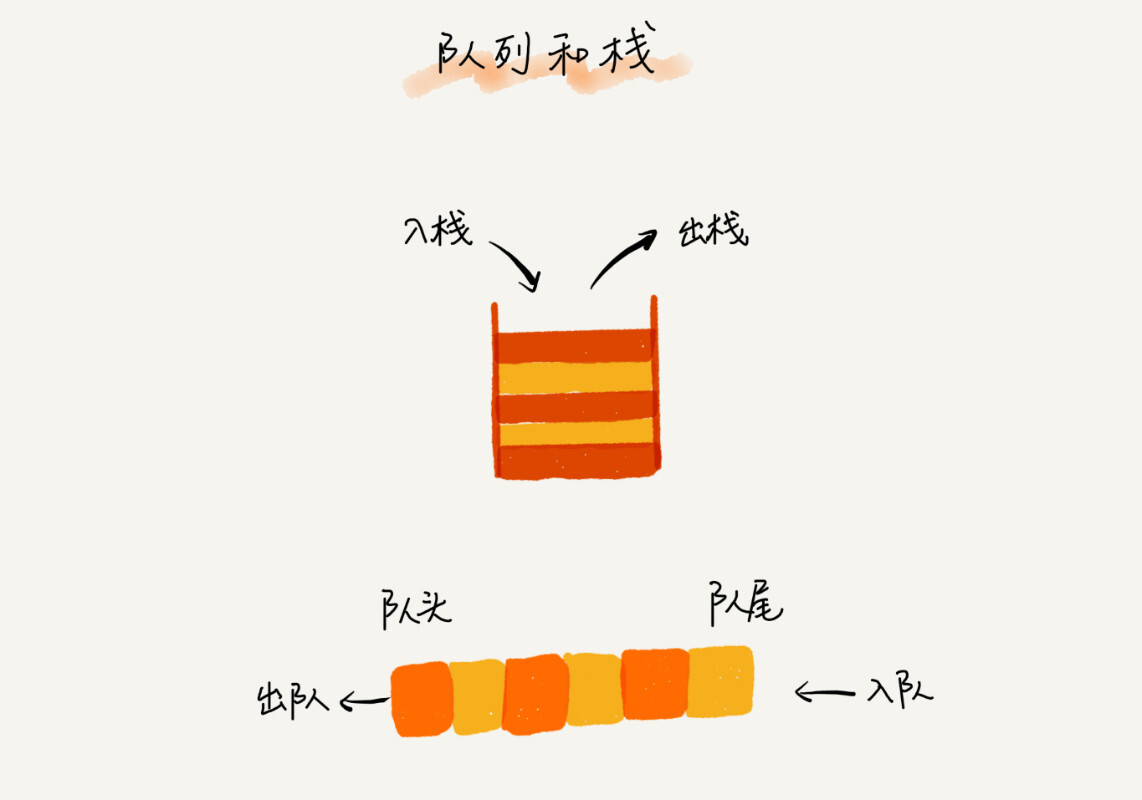版权声明:本文为博主原创文章,未经博主允许不得转载。 https://blog.csdn.net/qq_26287435/article/details/83509346
Java实现队列——顺序队列、链式队列
概念
先进者先出,这就是典型的“队列”。(First In, First Out,FIFO)。
我们知道,栈只支持两个基本操作:入栈push()和出栈pop()。队列跟栈非常相似,支持的操作也很有限,最基本的操作也是两个:入队和出队。入队 enqueue(),让一个数据到队列尾部;出队 dequeue(),从队列头部取一个元素。

所以,队列跟栈一样,也是一种操作受限的线性表数据结构。
跟栈类似,用数组实现的队列叫做顺序队列,用链表实现的队列叫做链式队列。下面我们看下如何用Java代码如何实现。
顺序队列
代码如下:
public class QueueBasedArray implements QueueInterface {
private String[] values;// 数组
private int capacity = 0;// 数组容量
private int head = 0;// 头部下标
private int tail = 0;// 尾部下标
public QueueBasedArray(int capacity) {
values = new String[capacity];
this.capacity = capacity;
}
@Override
public Boolean enqueue(String value) {
// tail == capacity 表示队列末尾没有空间了
if (tail == capacity) {
// tail == capacity && head == 0 表示整个队列都占满了。
if (head == 0) {
return false;
}
// 数据搬移
for (int i = head; i < tail; i++) {
values[i - head] = values[i];
}
// 搬移完成后更新 head 和 tail
tail -= head;
head = 0;
}
values[tail] = value;
tail++;
return true;
}
@Override
public String dequeue() {
// 如果 head == tail 表示队列为空
if (0 == tail) {
return null;
}
String result = values[head];
head++;
return result;
}
@Override
public String toString() {
return "QueueBasedArray{" +
"values=" + Arrays.toString(values) +
", capacity=" + capacity +
", head=" + head +
", tail=" + tail +
'}';
}
}
测试代码:
QueueBasedArray qba = new QueueBasedArray(10);
System.out.println(qba);
for (int i = 0; i < 10; i++) {
qba.enqueue("" + i + i + i);
}
System.out.println(qba);
for (int i = 0; i < 10; i++) {
qba.dequeue();
System.out.println(qba);
}
for (int i = 11; i < 20; i++) {
qba.enqueue("" + i + i + i);
}
System.out.println(qba);
输出结果:符合预期
QueueBasedArray{values=[null, null, null, null, null, null, null, null, null, null], capacity=10, head=0, tail=0}
QueueBasedArray{values=[000, 111, 222, 333, 444, 555, 666, 777, 888, 999], capacity=10, head=0, tail=10}
QueueBasedArray{values=[000, 111, 222, 333, 444, 555, 666, 777, 888, 999], capacity=10, head=1, tail=10}
QueueBasedArray{values=[000, 111, 222, 333, 444, 555, 666, 777, 888, 999], capacity=10, head=2, tail=10}
QueueBasedArray{values=[000, 111, 222, 333, 444, 555, 666, 777, 888, 999], capacity=10, head=3, tail=10}
QueueBasedArray{values=[000, 111, 222, 333, 444, 555, 666, 777, 888, 999], capacity=10, head=4, tail=10}
QueueBasedArray{values=[000, 111, 222, 333, 444, 555, 666, 777, 888, 999], capacity=10, head=5, tail=10}
QueueBasedArray{values=[000, 111, 222, 333, 444, 555, 666, 777, 888, 999], capacity=10, head=6, tail=10}
QueueBasedArray{values=[000, 111, 222, 333, 444, 555, 666, 777, 888, 999], capacity=10, head=7, tail=10}
QueueBasedArray{values=[000, 111, 222, 333, 444, 555, 666, 777, 888, 999], capacity=10, head=8, tail=10}
QueueBasedArray{values=[000, 111, 222, 333, 444, 555, 666, 777, 888, 999], capacity=10, head=9, tail=10}
QueueBasedArray{values=[000, 111, 222, 333, 444, 555, 666, 777, 888, 999], capacity=10, head=10, tail=10}
QueueBasedArray{values=[111111, 121212, 131313, 141414, 151515, 161616, 171717, 181818, 191919, 999], capacity=10, head=0, tail=9}
链式队列
代码如下:
public class QueueBasedLinkedList implements QueueInterface {
private Node head;
private Node tail;
/**
* 入队
*
* @param value
* @return
*/
@Override
public Boolean enqueue(String value) {
Node newNode = new Node(value, null);
// tail为null,表示队列中没有数据
if (null == tail) {
head = newNode;
tail = newNode;
} else {
tail.next = newNode;
tail = newNode;
}
return true;
}
/**
* 出队
*
* @return
*/
@Override
public String dequeue() {
// head == null,表示队列为空。
if (null == head) {
return null;
}
// 获取数据
String value = head.getItem();
// 移除头结点,让head指向下一个结点。
head = head.next;
// 如果此时的头结点指向null,说明队列已空,需要将tail指向null.
if (null == head) {
tail = null;
}
return value;
}
@Override
public String toString() {
return "QueueBasedLinkedList{" +
"head=" + head +
", tail=" + tail +
'}';
}
private static class Node {
String item;
private Node next;
public Node(String item, Node next) {
this.item = item;
this.next = next;
}
public String getItem() {
return item;
}
@Override
public String toString() {
return "Node{" +
"item='" + item + '\'' +
", next=" + next +
'}';
}
}
}
测试代码:
// 空队列
QueueBasedLinkedList qbll = new QueueBasedLinkedList();
System.out.println("空队列 " + qbll);
System.out.println();
// 入队一个数据
System.out.println("数据入队是否成功:" + qbll.enqueue("0000"));
System.out.println("入队一个数据后:" + qbll);
System.out.println();
// 出队一个数据
System.out.println("出队的数据是:" + qbll.dequeue());
System.out.println("出队一个数据后:" + qbll);
System.out.println();
// 异常测试:从空队列中出队,看结果
System.out.println("出队的数据是1:" + qbll.dequeue());
System.out.println("出队一个数据后1:" + qbll);
System.out.println();
// 入队十条数据
for (int i = 0; i < 10; i++) {
System.out.println("数据入队是否成功:" + qbll.enqueue("" + i + i + i));
System.out.println(qbll);
}
输出结果:符合预期
空队列 QueueBasedLinkedList{head=null, tail=null}
数据入队是否成功:true
入队一个数据后:QueueBasedLinkedList{head=Node{item='0000', next=null}, tail=Node{item='0000', next=null}}
出队的数据是:0000
出队一个数据后:QueueBasedLinkedList{head=null, tail=null}
出队的数据是1:null
出队一个数据后1:QueueBasedLinkedList{head=null, tail=null}
数据入队是否成功:true
QueueBasedLinkedList{head=Node{item='000', next=null}, tail=Node{item='000', next=null}}
数据入队是否成功:true
QueueBasedLinkedList{head=Node{item='000', next=Node{item='111', next=null}}, tail=Node{item='111', next=null}}
数据入队是否成功:true
QueueBasedLinkedList{head=Node{item='000', next=Node{item='111', next=Node{item='222', next=null}}}, tail=Node{item='222', next=null}}
数据入队是否成功:true
QueueBasedLinkedList{head=Node{item='000', next=Node{item='111', next=Node{item='222', next=Node{item='333', next=null}}}}, tail=Node{item='333', next=null}}
数据入队是否成功:true
QueueBasedLinkedList{head=Node{item='000', next=Node{item='111', next=Node{item='222', next=Node{item='333', next=Node{item='444', next=null}}}}}, tail=Node{item='444', next=null}}
数据入队是否成功:true
QueueBasedLinkedList{head=Node{item='000', next=Node{item='111', next=Node{item='222', next=Node{item='333', next=Node{item='444', next=Node{item='555', next=null}}}}}}, tail=Node{item='555', next=null}}
数据入队是否成功:true
QueueBasedLinkedList{head=Node{item='000', next=Node{item='111', next=Node{item='222', next=Node{item='333', next=Node{item='444', next=Node{item='555', next=Node{item='666', next=null}}}}}}}, tail=Node{item='666', next=null}}
数据入队是否成功:true
QueueBasedLinkedList{head=Node{item='000', next=Node{item='111', next=Node{item='222', next=Node{item='333', next=Node{item='444', next=Node{item='555', next=Node{item='666', next=Node{item='777', next=null}}}}}}}}, tail=Node{item='777', next=null}}
数据入队是否成功:true
QueueBasedLinkedList{head=Node{item='000', next=Node{item='111', next=Node{item='222', next=Node{item='333', next=Node{item='444', next=Node{item='555', next=Node{item='666', next=Node{item='777', next=Node{item='888', next=null}}}}}}}}}, tail=Node{item='888', next=null}}
数据入队是否成功:true
QueueBasedLinkedList{head=Node{item='000', next=Node{item='111', next=Node{item='222', next=Node{item='333', next=Node{item='444', next=Node{item='555', next=Node{item='666', next=Node{item='777', next=Node{item='888', next=Node{item='999', next=null}}}}}}}}}}, tail=Node{item='999', next=null}}
完整代码请查看
项目中搜索SingleLinkedList即可。
github传送门 https://github.com/tinyvampirepudge/DataStructureDemo